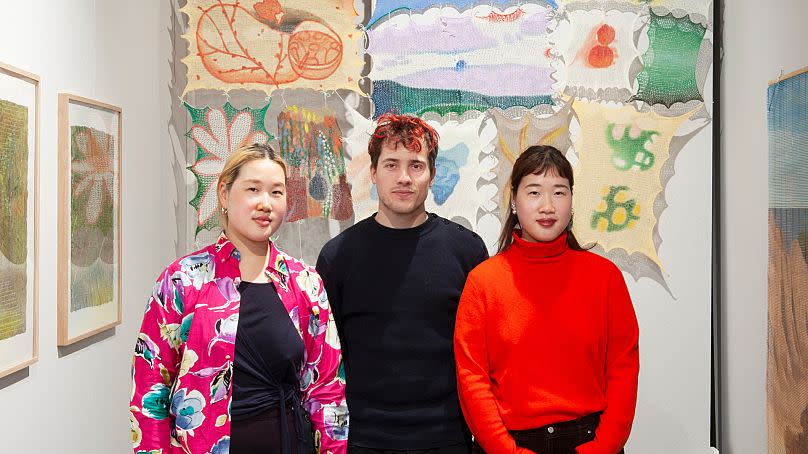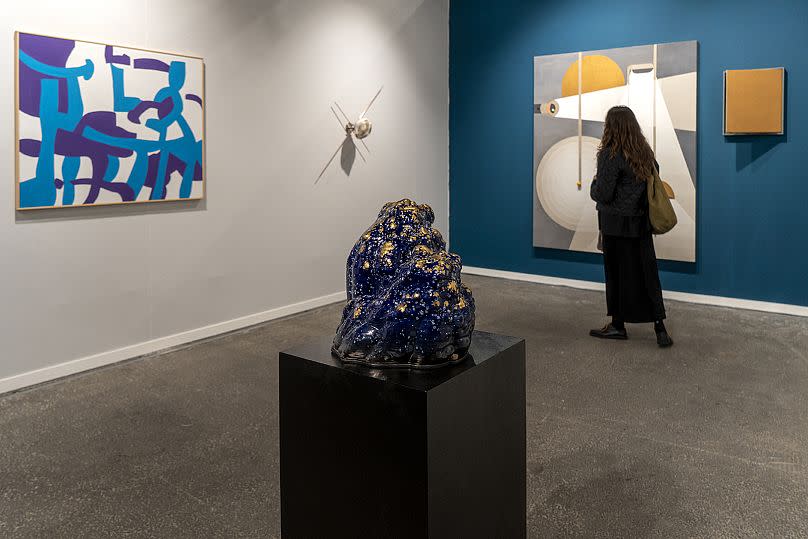Back from the dead: Paris' vibrant art scene takes centre stage at 'Art Paris'

For years, the global art world saw the French capital as a shadow of its former self – a place with a storied history but a less than dazzling future.
If this year’s edition of ‘Art Paris’ is anything to go by, it’s safe to say the City of Lights has successfully shaken that reputation. The annual modern and contemporary art fair, which for years struggled to get big-name galleries to attend, this year received 350 applications for 134 spots.
“We’re seeing this movement today, which is historic,” Director of Art Paris Guillaume Piens told Euronews Culture. “I’ve been organising art shows for 23 years and I’ve never seen anything like this. We’re seeing prestigious foreign galleries opening locations in Paris, which we haven’t seen in a long time.”
The city’s vibrant new art scene – born from a concerted effort between French artists, gallerists and private foundations, according to Piens – has revived Paris’ status in the art world, making it a top destination for art dealers and collectors in Europe.
Under the shadow of the Eiffel Tower at the Grand Palais Éphémère, Art Paris gathered the who’s who of the French gallery scene, from major players like Perrotin and Templon to rising stars like Anne-Laure Buffard.
A dynamic art landscape
After 11 years at the established Parisian contemporary art gallery Galerie Nathalie Obadia, Buffard decided to venture out on her own in 2022.
“I met these two Korean artists, Park Chae Dalle and Park Chae Biole, whose work I’m exhibiting at Art Paris,” Buffard told Euronews Culture. “I was so smitten, so excited about their work that I decided to take the leap to defend it.”

The twin sisters, born in 1997, work side by side to produce pieces that are distinct but complementary - Dalle often knits her own canvases while Biole will paint on bamboo blinds. Both are concerned with how bodies interact with their art and the space around it.
After organising the sisters’ first show in 2022, Buffard created her gallery with a hybrid model – she has a showroom in an apartment in central Paris, where she receives visitors by appointment only. She also organises exhibitions in shared spaces or galleries that she’ll rent out.
“It gives me a lot of flexibility,” Buffard said. “I always have new works from my artists on the walls (of the apartment) and it’s an intimate setting where it’s possible to exchange with artists, or institutions, or collectors, or journalists, etc.”
The challenge, she says, is competing with larger galleries that have more resources. She works hard to stand out by making booklets for each show in collaboration with critics and artists.
Buffard is a prime example of the type of forward-thinking young gallerists that are breathing new life into the Paris art market, by taking risks and offering something different.
“We shouldn’t shoot ourselves in the foot”
France has increased its share of the global market from 3% to 7% over the past 20 years, and it’s now taking in more than half of Europe’s total art sale revenues.
But this year, a new EU tax directive has been worrying many French gallerists, big and small, who fear it could sabotage Paris’ upward trajectory. The directive, set to take effect in January 2025, would raise the VAT tax on artwork sold in France from 5.5% to 20%.
For small galleries like Buffard’s, which represent up-and-coming artists, it would make a difficult task even harder.
“It’s concerning. Contemporary artists make a living from the sale of their works, so the income they earn gets eaten away when you add VAT to it,” Buffard said. “And generally young galleries take the most risks by supporting artists that are lesser-known, so it could threaten France’s most fragile art scene, which is also the richest and most interesting.”

But even more established galleries are worried. Galerie Templon, a contemporary art gallery with offices in Paris, New York and Brussels, said the tax would penalise sales of imported art in France and give galleries in Switzerland or London an unfair advantage.
“Just because the (French) art market looks like it’s thriving doesn’t mean we should shoot ourselves in the foot,” Templon’s Executive Director Anne-Claudie Coric told Euronews Culture. “I don’t think we would be forced to move elsewhere, because we’re a French gallery, a European gallery. We’re not going to change our identity over a regulatory issue. (...) But there would be less business (in France).”
France’s Professional Committee of Art Galleries (CPGA) has been in talks with the government to find a solution to protect the art market from a higher tax rate, with a decision expected by autumn.
“We gallerists are putting up a very united front,” said Yves Zlotowski, director of the modern art Galerie Zlotowski. “We’re lucky to have a very active union that defends the art market and Paris’ rising place in it. We can’t let this rise be stopped by a regulation that could drastically undercut growth.”
Art Paris is open to the public at Paris' Grand Palais Éphémère from 30 March to 2 April.

 Yahoo News
Yahoo News 
